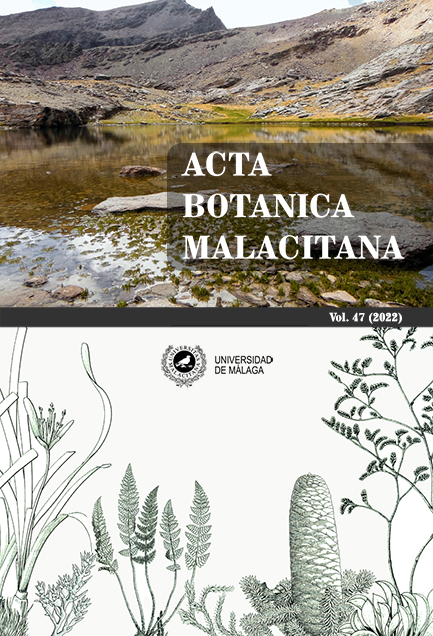New locality for Juniperus thurifera L.(Cupressaceae) in the province of Granada (Spain)
DOI:
https://doi.org/10.24310/abm.v47i.15183Keywords:
Juniperus thurifera, SE Iberian Peninsula, relictic populationAbstract
We have located a population of Juniperus thurifera L. (Spanish juniper) of 34 individuals in the municipality of Guadahortuna (Granada), a relict species of the Tertiary flora associated with the continental mediterranean climate. The Spanish juniper enjoys large and numerous populations in the center of the peninsula and the Iberian System. On the other hand, the populations of this species are reduced to small groups or isolated individuals in the Iberian Southeast. This population is located at the limit of the distribution of the species, so it presents high values for plant conservation and chorology oriented towards afforestation actions.
Downloads
Metrics
References
Alonso, R., Sánchez-Palomares, O., Roig, S., López, E. & Gandullo, J.M. (2010). Las estaciones ecológicas actuales y potenciales de los sabinares albares españoles. Monografías INIA, Serie Forestal, 19, 80-106.
Bertaudière, V., Montes, N., Gauquelin, T. & Édouard, J.L. (1999). Dendroécologie du genévrier thurifère (Juniperus thurifera L.): exemple de la thuriféraie de la montagne de Rié (Pyrénées, France). Annals of Forest Science, 56(8), 685-697. https://doi.org/10.1051/forest:19990806
García, J.M. & Allué, C. (2006). Relaciones de competencia interespecífica en sabinares albares (Juniperus thurifera L.) de la península ibérica. Una aproximación fitoclimática. En Actas del III Coloquio Internacional sobre Sabinares y Enebrales (Gen. Juniperus): ecología y gestión forestal sostenible, Tomo I (pp. 71-78). Soria: Portal Forestal de Castilla y León.
Gómez Manzaneque, F., Costa, M., Morla, C. & Sainz, H. (2000). Elementos para una interpretación paleogeográfica de los sabinares albares de la Península Ibérica. Actes du Colloque International de Marignac (Haute-Garonne, France) Office national des forêts -Les Dossiers Forestiers, 6, 171-178.
López González, G. (2001). Los Árboles y Arbustos de la Península Ibérica e Islas Baleares, Tomo I. Madrid: Ediciones Mundi-Prensa.
Lorite, J., Navarro, F.B., Salazar, C. & Valle, F. (2000). Comparative study of Juniperus thurifera L. formations in the Betic mountains (SE Spain). Actes du Colloque International de Marignac (Haute-Garonne, France). Office national des forêts-Les Dossiers Forestiers, 6, 53-61.
MITECO (2023). Ministerio para la Transición Ecológica y el Reto Demográfico, portal de datos e inventarios. Inventario Español de Especies Terrestres. Impactos, vulnerabilidad y adaptación al cambio climático de la biodiversidad española. Flora y vegetación. Letra J. Juniperus thurifera. https ://www.miteco.gob.es/es/biodiversidad/temas/inventarios-nacionales/Juniperus_thurifera_tcm30-200432.pdf. Consulta realizada el 02 de Noviembre de 2023.
Montesinos, D. (2007). Juniperus thurifera: una especie dioica, vecera y relíctica. Ecosistemas, 2007(3), 1-14.
Pérez Latorre, A. V. & Cabezudo, B. (2009). Gimnospermas. En G. Blanca, B. Cabezudo, M. Cueto, C. Fernández López. & C. Morales Torres (eds.), Flora Vascular de Andalucía Oriental 1 (pp. 182–186). Sevilla: Consejería de Medio Ambiente, Junta de Andalucía.
REDIAM (2022). Red de Información Ambiental de Andalucía. Unidades edáficas de Andalucía 1:400.000 y Sectores biogeográficos de Andalucía a escala de detalle (1:10.000). Recursos electrónicos consultados disponibles en https://portalrediam.cica.es/VisorRediam/. Consulta realizada en 20 de junio de 2022.
Vílchez, J.A., Marruecos, J.M., Jiménez, M.N., Navarro, F.B. (2021). Characterization of the Spanish juniper population of El Peñón de Alamedilla (Granada, Spain): conservation status and protection proposal. Forest Systems, 30 (2), eSC04. https://doi.org/10.5424/fs/2021302-17897.
Downloads
Published
How to Cite
Issue
Section
License
Those authors who publish in this journal accept the following terms:
a. The authors will retain their copyrights and guarantee the journal the right of first publication of their work, which will be simultaneously subject to the Creative Commons Attribution-Non-commercial 4.0 license whose full text can be found at <http: // creative commons .org / licenses / by-nc / 4.0> that allows third parties to share the work as long as its author and its first publication are indicated, and as long as it is not for commercial purposes.
b. Authors may adopt other non-exclusive licensing agreements for the distribution of the version of the published paper (e.g., deposit it in an institutional telematic file or publish it in a monographic volume) provided that the initial publication in this journal be indicated.
c. Authors are allowed and recommended to disseminate their work through the Internet (e.g., in institutional telematic archives or on their websites) before and during the submission process, which can produce interesting exchanges and increase citations of the published work. (See The effect of open access)







1.png)
